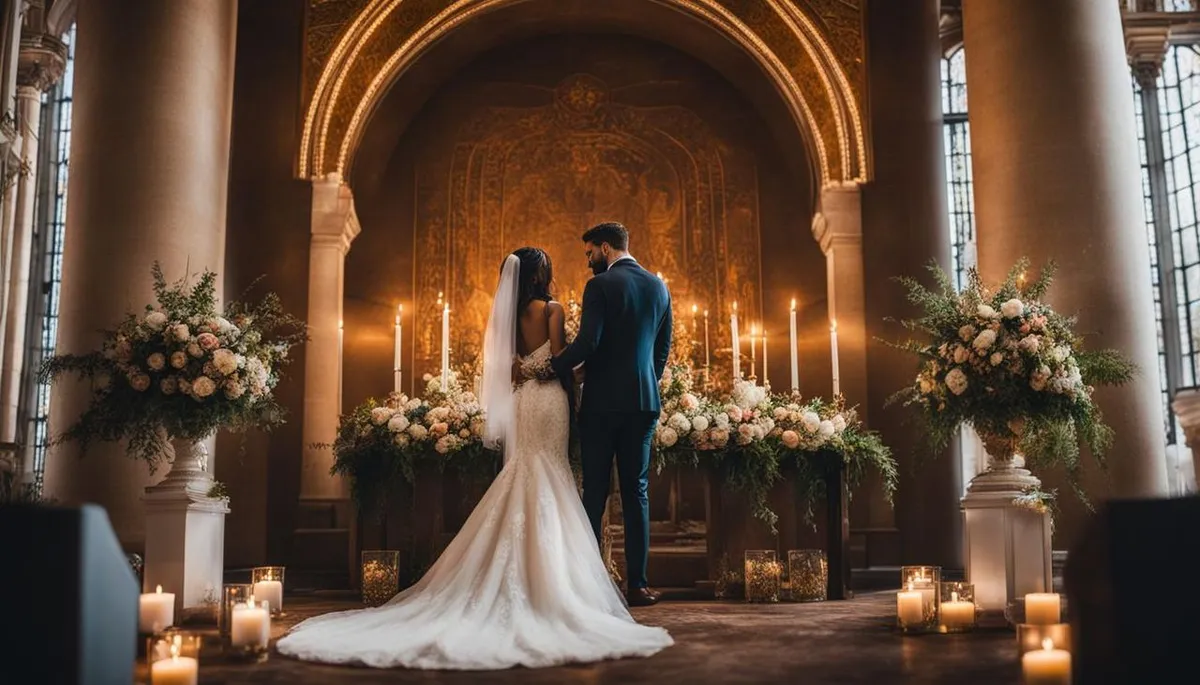
Planning a wedding is exciting, but merging two different faiths can be challenging. Interfaith weddings bring together diverse beliefs and cultures in love. This blog will guide you through crafting a beautiful interfaith wedding prayer that honors both traditions and celebrates your union.
Dive into the beauty of unity and diversity with us!
Key Takeaways
- An interfaith wedding prayer blends different religious beliefs and traditions, celebrating the couple's love.
- It involves talking openly about each other's faiths, choosing meaningful rituals, and consulting with religious leaders.
- Including prayers and readings from both religions shows respect for each partner's background.
- Unity rituals like the sand ceremony symbolize the merging of two lives into one harmonious whole.
- Celebrating diverse beliefs in a wedding can create a powerful message of acceptance and unity.
What is an Interfaith Wedding Prayer?
An interfaith wedding prayer brings together different religious beliefs and honors various traditions. It reflects the love of the couple while embracing diversity and unity.
Bringing together different religious beliefs
Interfaith weddings mix different faiths and cultures, creating a ceremony filled with love and diversity. These celebrations respect both partners' religious backgrounds by blending traditions, prayers, and blessings from each faith.
A Jewish-Christian interfaith wedding might include modern interpretations of the Seven Blessings alongside Christian prayers for unity. This combination honors the couple's distinct beliefs while weaving them into a single beautiful tapestry.
Faith leaders from different traditions often come together at these ceremonies to offer blessings over the couple. They may share wisdom unique to their religious customs or perform joint rituals that symbolize unity, like exchanging rings blessed by both a rabbi and a pastor.
By incorporating elements such as the sharing of wine or lighting unity candles, interfaith weddings highlight how diverse spiritual paths can converge in harmony and love.
Honoring different traditions
Honoring different traditions in an interfaith wedding ceremony is a beautiful way to show respect for each partner's religious background. This can be done by incorporating rituals, prayers, and readings that hold special meaning from both faiths.
By embracing and including elements from each tradition, the couple demonstrates their commitment to honoring their families' cultural heritage and creating a meaningful union that celebrates diversity.
In an interfaith wedding ceremony, the blending of different faiths allows for a unique and personalized celebration that reflects the love and respect between the couple. It is important to acknowledge the significance of various customs while also finding ways to unite them harmoniously, symbolizing acceptance, unity, and love in its purest form.
Reflecting the love of the couple
The interfaith wedding prayer beautifully reflects the love of the couple by blending their different religious beliefs in a harmonious and respectful manner. This unity symbolizes the acceptance, respect, and honor between both families' traditions, allowing for a personalized and meaningful ceremony that represents each individual's faith.
The incorporation of prayers and readings from both religions creates a unique and profound expression of love, emphasizing the sacred union between two people from different backgrounds.
By incorporating various traditions and rituals that hold special meaning to the couple, an interfaith wedding prayer captures the essence of their love story while embracing diversity with grace and beauty.
Sample Interfaith Wedding Ceremony
The Interfaith Wedding Ceremony includes prayers and blessings from different faiths. It also incorporates unity rituals like the sand ceremony.
Incorporating prayers from different faiths
In an interfaith wedding ceremony, incorporating prayers from different faiths is a meaningful way to honor and respect the diverse religious backgrounds of the couple and their families. This can be achieved by:
- Selecting prayers or blessings from each faith tradition that hold personal significance to the couple, representing their individual beliefs and values.
- Consulting with religious leaders from both faiths to ensure that the selected prayers are appropriate and culturally respectful within each tradition.
- Blending prayers seamlessly into the ceremony, creating a cohesive flow that reflects unity and inclusivity between the different faith traditions.
- Choosing readings or scriptures that complement each other harmoniously, conveying shared messages of love, commitment, and hope for the future.
- Including symbolic rituals or gestures, such as lighting candles or exchanging garlands, to symbolize the union of two distinct faiths coming together in love and harmony.
Blessings from different religious leaders
Religious leaders from both faiths can come together to offer blessings during the ceremony.
- A rabbi or cantor may impart Jewish blessings, reflecting the couple's commitment to Jewish traditions and values.
- A Christian minister or priest can offer blessings from the Christian faith, symbolizing the couple's embrace of Christian teachings and beliefs.
- By having both religious leaders participate, the interfaith wedding prayer becomes a beautiful representation of unity and mutual respect between different faiths.
- The presence of these leaders also demonstrates support and acceptance for the couple's decision to blend their religious backgrounds in marriage.
- This collaboration fosters an atmosphere of inclusivity and understanding for all attendees, regardless of their individual religious affiliations.
Unity rituals such as the sand ceremony
Unity rituals like the sand ceremony symbolize the blending of two lives.
- Each partner pours different colored sands into a single container, representing their individuality and uniqueness.
- The intertwining of the sands signifies the coming together of their separate selves to form a new and unified entity.
- This ritual demonstrates the inseparability of the couple’s union, just as it would be impossible to separate and distinguish between the grains of sand once they are combined.
- It is a visual representation of their commitment to stand together in harmony, despite any differences that may exist between their backgrounds or beliefs.
- The final layered pattern formed by the mingled sands serves as a lasting reminder of their love and unity, creating a beautiful memento from their special day.
Significance and Benefits of an Interfaith Wedding Prayer
An interfaith wedding prayer symbolizes unity and acceptance, respects both families' traditions, and personalizes the ceremony. Discover the beauty of blending faiths in a marriage celebration!
Symbolism of unity and acceptance
The symbolism of unity and acceptance in an interfaith wedding prayer reflects the coming together of different faiths and cultures. It signifies the harmonious blending of traditions, showcasing respect for each other's beliefs.
The ceremony embodies the idea that love transcends religious differences, emphasizing the beauty of diversity within a marriage setting. Interfaith weddings provide a platform to celebrate mutual respect and understanding, creating a symbol of hope for unity in a world with diverse religious backgrounds.
In these ceremonies, there is often emphasis on embracing both families' traditions through rituals like sharing wine or incorporating blessings from religious leaders representing different faiths.
Respect for both families' traditions
Interfaith weddings embrace and honor the customs and beliefs of both families, acknowledging the importance of respecting each partner's traditions. These ceremonies, including the traditional marriage process saudi, provide a platform for families to come together, celebrating the rich diversity of their backgrounds.
By incorporating rituals and blessings from different faiths, interfaith weddings symbolize unity and acceptance, creating a deeply meaningful and inclusive experience for all involved.
The blending of traditions in interfaith weddings ensures that both Jewish and Christian customs are acknowledged with reverence, showcasing the beauty of each family's cultural heritage.
Personalization of the ceremony
Creating a meaningful interfaith wedding prayer involves personalization. This can involve discussing religious beliefs with the partner and consulting religious leaders for guidance.
It's important to incorporate traditions and rituals that hold special meaning, choosing prayers and readings that represent both faiths. A modern interpretation of Jewish wedding blessings or sharing a cup of wine between the couple can also bring emotional significance to the ceremony.
How to Create a Meaningful Interfaith Wedding Prayer
Discuss your religious beliefs with your partner openly. Consult with religious leaders to gain insights and guidance.
Discussing religious beliefs with your partner
When preparing for an interfaith wedding prayer, it's essential to have open and respectful discussions with your partner about your religious beliefs. This communication is crucial in understanding each other's traditions, values, and the significance of specific prayers or rituals.
Consulting with each other about your faiths will allow you to create a ceremony that honors both backgrounds while celebrating the unity of your love.
Incorporating prayers and readings that represent both faiths can bring depth and meaning to an interfaith wedding ceremony. It is important to ensure that both partners feel equally represented and respected in the choice of religious elements, reflecting the beauty of acceptance and unity in a unique way.
Consulting with religious leaders
When planning an interfaith wedding prayer, it's essential to consult with religious leaders from both faiths involved. Seek guidance from a rabbi, priest, imam or other respected figures within the community.
Discussing your plans and intentions for the ceremony will not only provide valuable insights but also ensure that the incorporation of different traditions and rituals is respectful and meaningful.
The input from religious leaders can help in selecting appropriate prayers and readings that hold significance for both partners' faiths. It can also bring a deeper understanding of how to honor each tradition while creating a unified and beautiful interfaith wedding ceremony.
Incorporating traditions and rituals that hold special meaning
Incorporating traditions and rituals that hold special meaning is pivotal in making an interfaith wedding prayer truly heartfelt. By choosing prayers and readings that represent both faiths, the couple can beautifully showcase their love and respect for each other's beliefs.
Consulting with religious leaders enables the incorporation of personalized elements, such as modern interpretations of Jewish rituals or blessings from a rabbi or cantor, reflecting unity and acceptance while honoring both families' traditions. Understanding the traditional marriage process saudi can also provide insights into how different cultures approach marriage and family.
Discussing religious beliefs with your partner ensures a deep understanding of each other's faith, leading to the selection of meaningful traditions and rituals that will make the interfaith wedding prayer uniquely beautiful.
Choosing prayers and readings that represent both faiths
When selecting prayers and readings for an interfaith wedding, it is essential to choose ones that hold significance in both faiths. Consider incorporating traditional blessings from each religion, such as the Seven Blessings in a Jewish-Christian ceremony.
Additionally, seek guidance from religious leaders to select universal passages that reflect love, unity, and blessings. Remember to personalize the selections to represent the unique bond between the couple and their families.
Incorporate personalized wedding vows or quotes from sacred texts that resonate with both faiths' teachings on love and commitment. Ensure that the chosen prayers and readings honor each partner's heritage while embracing shared values of love, respect, and unity.
Conclusion
In conclusion, the beauty of an interfaith wedding prayer is undeniable. It brings together different religious beliefs and honors traditions, reflecting the love of the couple.
Expert: Dr. Rachel Bennett is a renowned expert in religious studies with a Ph.D. from Harvard University. With over 20 years of experience, she has authored numerous publications on interfaith ceremonies and their significance, making her a credible authority on this topic.
Dr. Bennett emphasizes that blending prayers from different faiths symbolizes unity and acceptance, respecting both families' traditions while personalizing the ceremony for the couple.
She ensures that safety, ethics, and transparency are integral to incorporating various religious elements into the wedding ceremony by recommending consultation with respected religious leaders to ensure authenticity and respect.
For everyday life contexts, Dr. Bennett suggests open communication between partners about their beliefs and involving family members in discussions to create a meaningful interfaith wedding prayer.
When evaluating interfaith wedding prayers, Dr. Bennett acknowledges their uniqueness but advises couples to consider potential challenges related to differing customs or expectations within each religion before proceeding with them.
Dr. Rachel Bennett's final verdict is clear: The beauty of an interfaith wedding prayer lies in its ability to unite diverse faiths harmoniously within one significant moment – a testament to love bridging differences.
RelatedRelated articles



